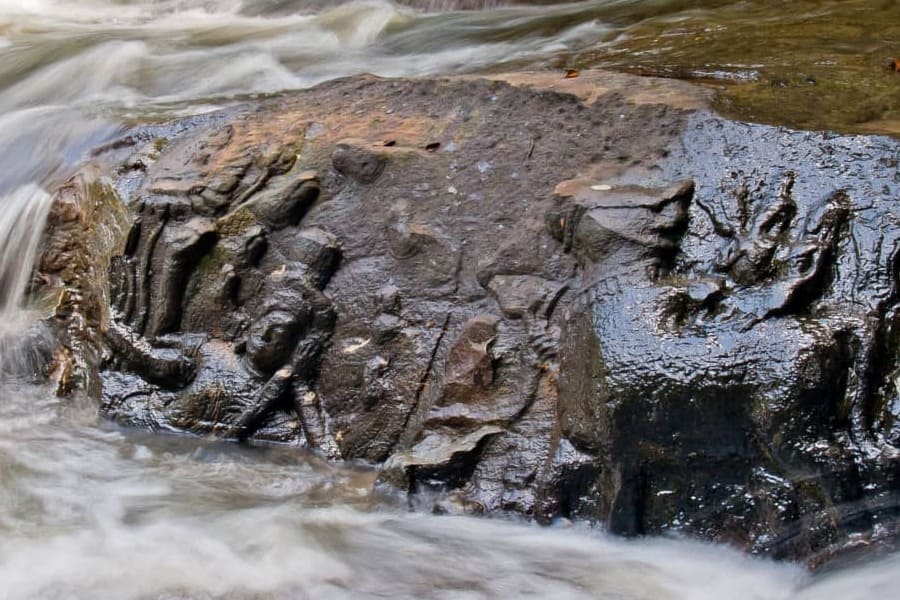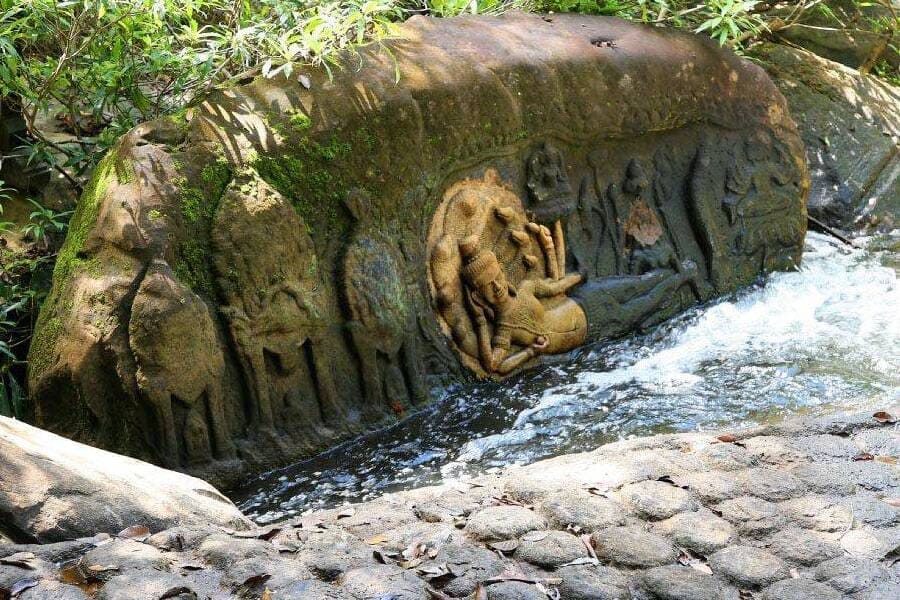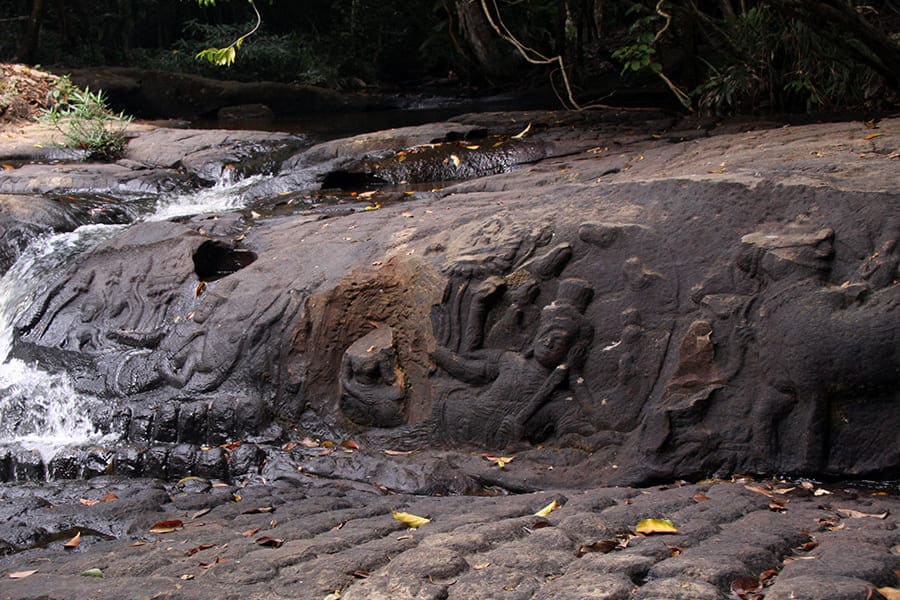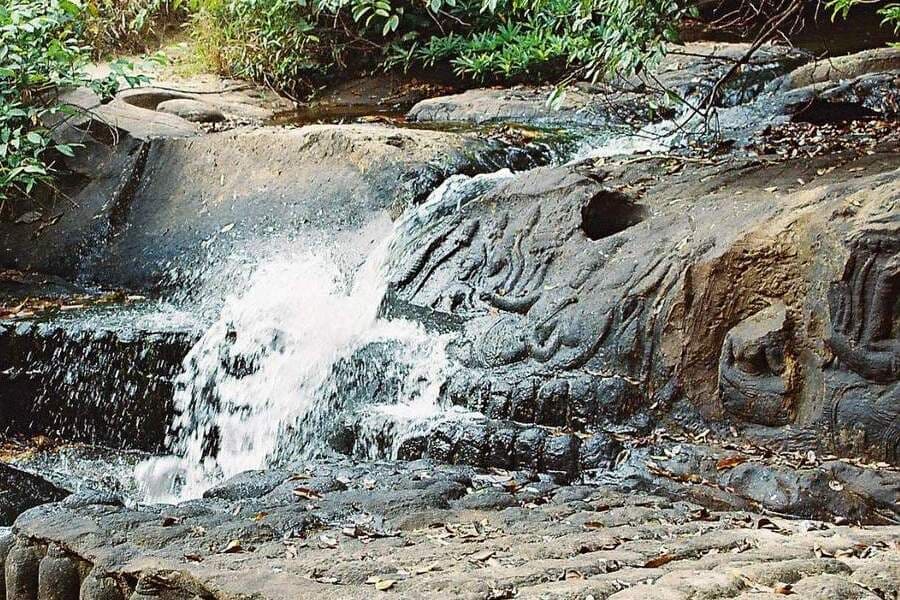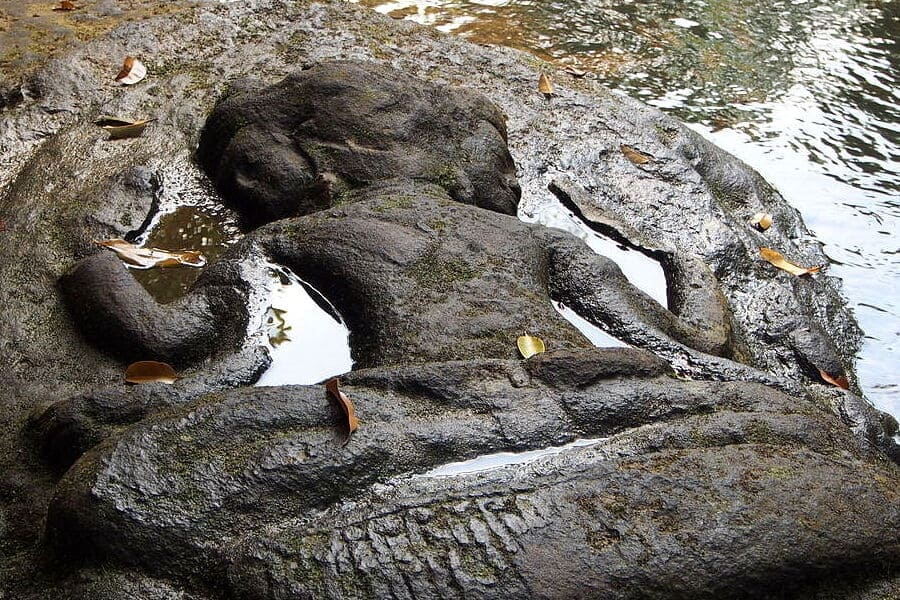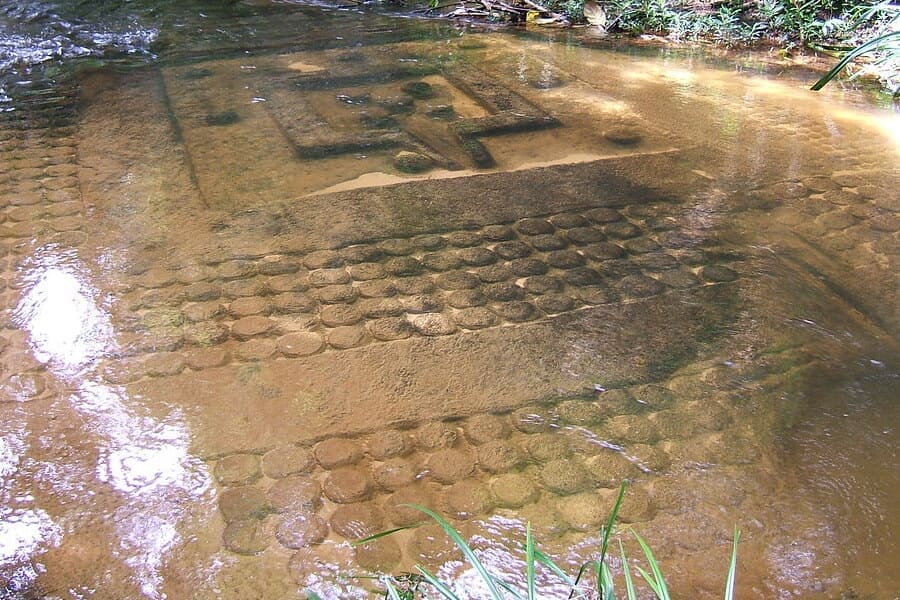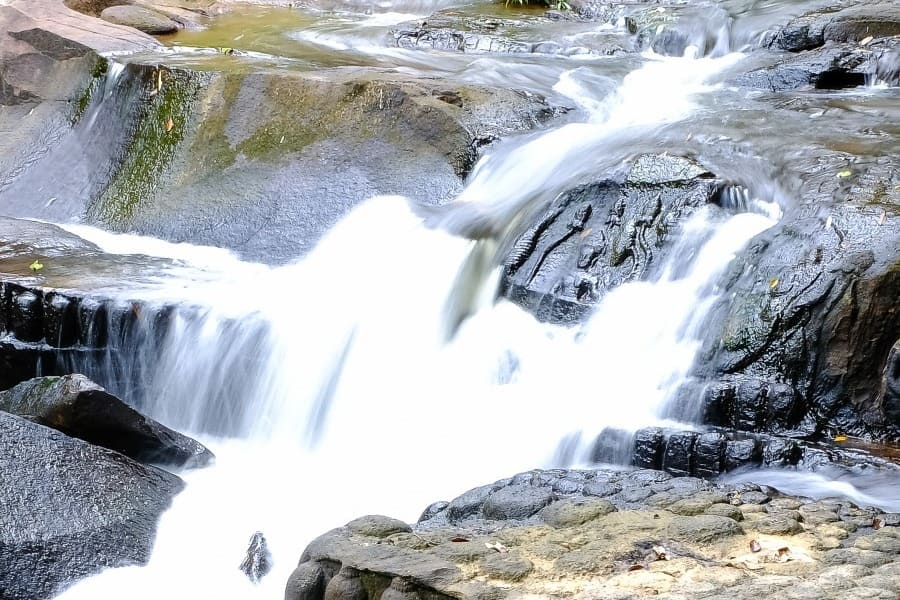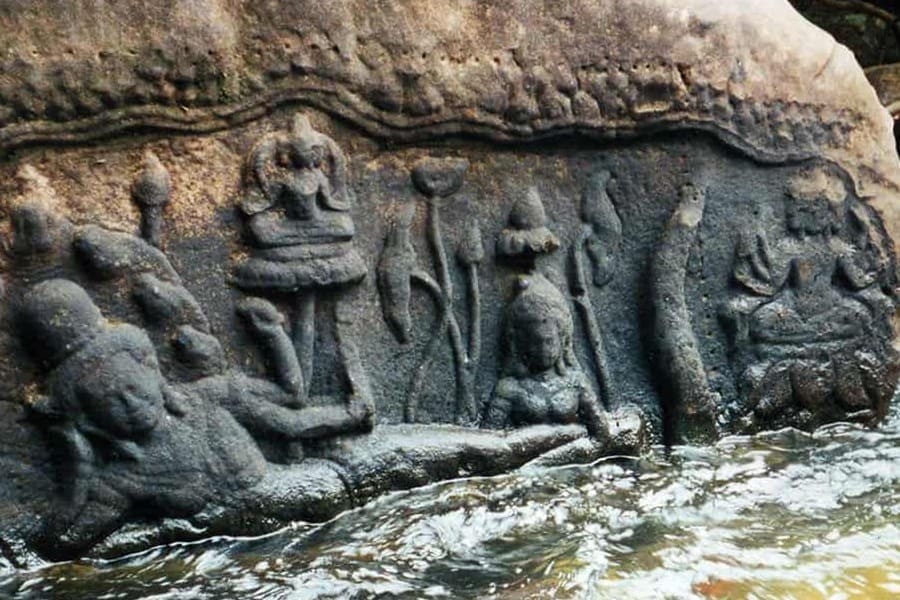Explore Kbal Spean during your Cambodia vacations, an intriguing archaeological site nestled within Phnom Kulen National Park. Known for its intricate riverbed carvings depicting Hindu deities and symbols, Kbal Spean offers a fascinating glimpse into Cambodia's ancient history and religious significance.
Contents
Introduction to Kbal Spean
Nestled within the serene confines of Phnom Kulen National Park in Cambodia lies the captivating archaeological site of Kbal Spean. Renowned for its remarkable riverbed carvings, Kbal Spean serves as a testament to the artistic and cultural legacy of the ancient Khmer Empire.
Etched into the rocky riverbeds, these intricate carvings date back to the 11th to 13th centuries, representing a sacred site imbued with spiritual significance. As visitors traverse the lush forests of Phnom Kulen National Park, they encounter a hidden treasure trove of Hindu mythological figures, divine deities, and sacred symbols meticulously carved into the sandstone.
Beyond its artistic allure, Kbal Spean holds a profound historical significance as a revered pilgrimage site during the Angkorian period. Pilgrims would embark on a journey to this sacred sanctuary to pay homage to the gods and seek spiritual blessings amidst the tranquil natural surroundings.
Historical background of Kbal Spean
The historical background of Kbal Spean traces back to the ancient Khmer Empire, particularly during the Angkorian period from the 9th to 15th centuries. Kbal Spean served as a sacred pilgrimage site and a revered religious sanctuary for worshippers during this time.
Located within the expansive Phnom Kulen National Park in Cambodia, Kbal Spean is renowned for its intricate riverbed carvings, which depict various Hindu deities, mythological figures, and sacred symbols. These carvings were created by skilled artisans under the patronage of Khmer kings, primarily during the reign of King Suryavarman I and his successors.
The carvings at Kbal Spean were intricately crafted into the sandstone riverbeds, symbolizing the sacred journey of the Ganges River, which is revered as a holy river in Hindu mythology. Pilgrims would embark on a spiritual journey to Kbal Spean to seek blessings and purification by bathing in the sacred waters flowing over the carvings.
Beyond its religious significance, Kbal Spean also served as a site for rituals and ceremonies conducted by priests and worshippers. The carvings depict scenes from Hindu mythology, including gods, goddesses, celestial beings, and scenes of daily life, offering insights into the religious beliefs and cultural practices of the Khmer people during the Angkorian period.
Over the centuries, Kbal Spean remained hidden amidst the dense forests of Phnom Kulen, known only to local villagers and occasional travelers. It wasn't until the early 20th century that French archaeologists rediscovered the site and began documenting its remarkable carvings and historical significance.
Today, Kbal Spean stands as a testament to Cambodia's rich cultural heritage and serves as a popular tourist destination for visitors seeking to explore the country's ancient past. Protected within the confines of Phnom Kulen National Park, Kbal Spean continues to attract pilgrims, historians, and curious travelers alike, offering a glimpse into the spiritual and artistic legacy of the Khmer civilization.
Riverbed Carvings at Kbal Spean
The riverbed carvings at Kbal Spean are a stunning testament to the artistic prowess and religious devotion of the ancient Khmer civilization. Etched into the sandstone riverbeds, these intricate carvings depict a rich tapestry of Hindu deities, mythological figures, and sacred symbols, offering a window into the spiritual and cultural beliefs of the Khmer people during the Angkorian period.
The carvings at Kbal Spean are characterized by their meticulous detail and exquisite craftsmanship. Skilled artisans painstakingly carved each figure with precision, creating lifelike representations of gods, goddesses, celestial beings, and scenes from Hindu mythology. From the graceful forms of Vishnu and Shiva to the divine beauty of Apsaras and Naga serpents, the carvings at Kbal Spean showcase a diverse array of subjects, each imbued with symbolic meaning and religious significance.
The artistic style of the carvings reflects the influence of both Indian and Khmer artistic traditions. Hindu iconography, such as the four-armed Vishnu and the dancing Shiva, is prevalent throughout the site, attesting to the strong cultural and religious ties between the Khmer Empire and the Indian subcontinent. At the same time, the carvings exhibit distinctive Khmer motifs and stylistic elements, including intricate patterns, floral designs, and architectural details that are unique to the region.
Symbolism plays a central role in the carvings at Kbal Spean, conveying layers of meaning and spiritual significance. Each deity and mythological figure depicted in the carvings represents a cosmic archetype or divine principle, embodying concepts such as creation, preservation, and destruction. The presence of sacred symbols, such as lotus flowers, conch shells, and the cosmic serpent Naga, further reinforces the religious symbolism of the carvings and their connection to Hindu cosmology.
Beyond their artistic and religious significance, the carvings at Kbal Spean also serve as a testament to the spiritual devotion of the Khmer people. Pilgrims would journey to this sacred site to seek blessings and purification by bathing in the waters flowing over the carvings, believing that the sacred symbols imbued the water with divine power and healing properties.
Today, the riverbed carvings at Kbal Spean continue to fascinate visitors with their beauty, complexity, and historical significance. Protected within the confines of Phnom Kulen National Park, these ancient carvings serve as a reminder of Cambodia's rich cultural heritage and the enduring legacy of the Khmer civilization.
Kbal Spean Tour Guide for Visitors
How to get to Kbal Spean?
Kbal Spean is located within Phnom Kulen National Park, approximately 50 kilometers northeast of Siem Reap city in Cambodia.
The most common way to reach Kbal Spean is by hiring a private car or tuk-tuk from Siem Reap. The journey takes about 1.5 to 2 hours, depending on road conditions.
Visitors can also join organized tours that include transportation to Kbal Spean as part of their itinerary.
Additional tips to Explore Kbal Spean
- Wear comfortable clothing and sturdy footwear suitable for hiking, as there is a moderate trek involved to reach the carvings at Kbal Spean. The trail is approximately [insert distance] and can take around [insert time].
- Bring plenty of water and sunscreen, as the hike can be strenuous, especially in hot weather.
- Consider hiring a local guide at the entrance of Kbal Spean to learn more about the history, significance, and interpretation of the carvings. Guides can provide valuable insights and enhance your overall experience.
- Respect the cultural and natural surroundings by staying on designated paths, refraining from touching or climbing on the carvings, and disposing of trash responsibly.
- Plan your visit during the dry season (November to April) for the best weather conditions and clearer views of the carvings. The rainy season (May to October) may result in muddy trails and swollen rivers, making hiking more challenging.
In conclusion, a Cambodia tour wouldn't be complete without a visit to Kbal Spean, a remarkable archaeological site nestled within the stunning landscapes of Phnom Kulen National Park. With its intricate riverbed carvings dating back to the ancient Khmer Empire, Kbal Spean offers a fascinating glimpse into Cambodia's rich cultural heritage and artistic legacy. Exploring this sacred sanctuary amidst the lush forests of Phnom Kulen is an unforgettable experience, inviting travelers to immerse themselves in the history, beauty, and spirituality of this unique destination.


